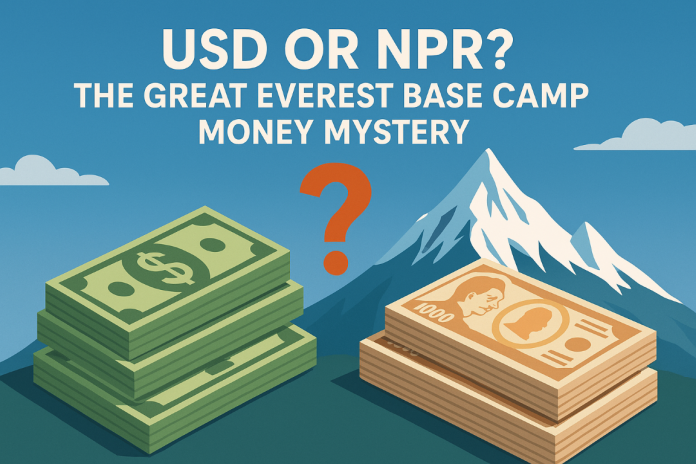So, you’re gearing up for your big trek to Everest Base Camp (EBC)—training your legs, stacking up on Snickers, and making sure your gear is on point. But wait, what about money? Should you carry US dollars (USD) or Nepalese rupees (NPR)? Will your fancy credit card work in the Himalayas? Let’s clear up this financial fog before you find yourself bartering a Snickers for a cup of tea at 4,000 meters!
Cash is King (And Queen, and Everything in Between)
First things first—you will need cash. A lot of it. Nepal isn’t exactly a tap-to-pay wonderland, and EBC is as remote as it gets. Sure, Namche Bazaar (the last major stop before you head deeper into the mountains) has a couple of ATMs, but they work only if there’s power and internet… and that’s a big IF.
So, what’s the best move? Exchange your cash in Kathmandu before heading out. Most places only accept NPR, and if they do take USD, they’ll probably give you an exchange rate that would make a banker cry.
Breakdown: Where You Need NPR
-
Permits – Yep, you need special permits to hike in the Everest region, and guess what? They don’t take credit cards at the checkpoint.
-
Transport to Ramechhap – If you’re flying to Lukla, you might have to first get to Ramechhap by road. Buses, jeeps—all take NPR.
-
Food & Water – Teahouses and shops only accept NPR. Imagine trying to buy a bottle of water with a $50 bill. Not gonna happen.
-
Accommodation – Most lodges and teahouses don’t have card machines, and those that do charge extra fees. Better to pay in NPR.
-
Miscellaneous Expenses – Snacks, charging your phone, WiFi, hot showers (yes, you have to pay for that), and tips—all need NPR.
Should You Carry a Card?
Some hotels and bigger lodges might accept credit cards, but there’s a catch:
-
A hefty service charge (5–10%)
-
Unreliable internet connections (meaning transactions might fail)
So while a card is good as a backup, don’t rely on it.
How Much Cash Should You Carry?
-
Budget travelers: ~$500–$700 in NPR should be enough for the trek.
-
Mid-range travelers: ~$1,000 in NPR to cover food, accommodation, and a few extras.
-
Luxury trekkers: If you want hot showers, extra snacks, and WiFi every night, bring at least $1,200 in NPR.
A Safe Bet:
Exchange around NPR 100,000 ($750–$800) in Kathmandu and keep an extra $200 in USD for emergencies.
Suggested Denominations to Carry
Break your NPR into smaller denominations so you’re not constantly asking for change in mountain villages (spoiler: they don’t have it).
Here’s a suggested breakdown for ~NPR 100,000:
-
NPR 1,000 x 40 = 40,000 (for permits, accommodation, big expenses)
-
NPR 500 x 60 = 30,000 (general use—meals, rides)
-
NPR 100 x 200 = 20,000 (great for snacks, showers, tipping)
-
NPR 50 x 100 = 5,000 (handy for tea, toilet fees, minor extras)
-
NPR 20 x 50 = 1,000 (backup coins-for-tea mode)
Pro tip: Keep small bills separate and accessible—you don’t want to pull out your whole stash just to pay for a momo plate.
Where to Exchange Money?
-
Thamel (Kathmandu) – Best rates, easiest exchange.
-
Lukla/Namche Bazaar – Exchange is possible, but rates are worse.
-
Hotels & Travel Agents – Convenient, but expect higher fees.
Final Money Tips for EBC Trek
✔ Always carry cash—no ATMs after Namche
✔ Break down your NPR into smaller bills (many places won’t have change for big notes)
✔ USD is good for emergencies but not daily expenses
✔ Exchange everything you need in Kathmandu—don’t wait until the trek starts
✔ Bring extra cash—just in case!
Still confused? Don’t worry, we’ve got more tips over at trekheaven.com—your one-stop information center for Trekking in Nepal.

